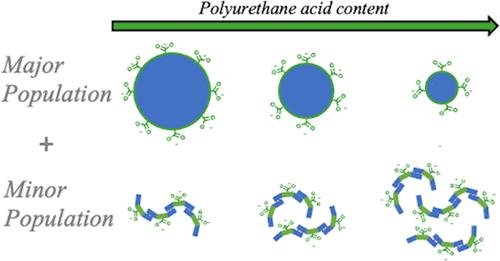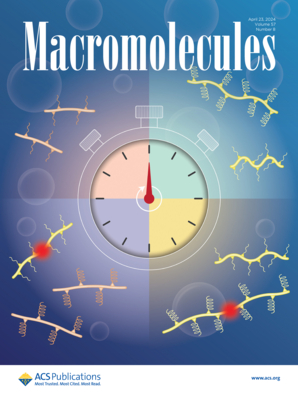酸性水性聚氨酯分散体的合成、形态和粒度控制
IF 5.1
1区 化学
Q1 POLYMER SCIENCE
引用次数: 0
摘要
我们合成了一系列电荷稳定的水性聚氨酯(PU)分散体,这些分散体由氢化亚甲基二苯基二异氰酸酯(H12MDI)与二羟甲基丙酸(DMPA)和乙二胺形成的硬段以及不同分子量的聚四亚甲基氧化物软段组成。利用质谱法、凝胶渗透色谱法、小角 X 射线散射法、原子力显微镜和红外光谱法对分散体进行的表征表明,分散体由自组装成球形颗粒的 PU(原生群)和由氢键连接的 H12MDI 和 DMPA 富酸片段形成的超分子结构(次生群)组成。利用基于质量守恒的结构模型对分散体的散射模式进行分析后发现,超分子结构的比例随着 DMPA 含量的增加而增加。研究还发现,聚氨酯颗粒半径与最初针对丙烯酸统计共聚物开发的颗粒表面电荷密度模型的预测结果一致,并受聚氨酯分子中亲水基(DMPA)含量的控制,聚氨酯酸度的增加会导致颗粒尺寸的减小。此外,在给定的聚醚软段分子量条件下,有一个临界的亲水基团覆盖率可以稳定颗粒表面,该覆盖率随聚醚分子量的增加而增加,这证明需要更多的酸性基团才能稳定更疏水的成分。本文章由计算机程序翻译,如有差异,请以英文原文为准。

Synthesis, Morphology, and Particle Size Control of Acidic Aqueous Polyurethane Dispersions
A range of charge-stabilized aqueous polyurethane (PU) dispersions comprising hard segments formed from hydrogenated methylene diphenyl diisocyanate (H12MDI) with dimethylolpropionic acid (DMPA) and ethylenediamine, and soft segments of poly(tetramethylene oxide) of different molecular weights are synthesized. Characterization of the dispersions by mass spectrometry, gel permeation chromatography, small-angle X-ray scattering, atomic force microscopy, and infrared spectroscopy shows that they are composed of PUs self-assembled into spherical particles (primary population) and supramolecular structures formed by hydrogen-bonded H12MDI and DMPA acid-rich fragments (secondary population). Analysis of the scattering patterns of the dispersions, using a structural model based on conservation of mass, reveals that the proportion of supramolecular structures increases with DMPA content. It is also found that the PU particle radius follows the predictions of the particle surface charge density model, originally developed for acrylic statistical copolymers, and is controlled by hydrophile (DMPA) content in the PU molecules, where an increase in PU acidity results in a decrease in particle size. Moreover, there is a critical fractional coverage of hydrophiles stabilizing the particle surface for a given polyether soft-segment molecular weight, which increases with the polyether molecular weight, confirming that more acid groups are required to stabilize a more hydrophobic composition.
求助全文
通过发布文献求助,成功后即可免费获取论文全文。
去求助
来源期刊

Macromolecules
工程技术-高分子科学
CiteScore
9.30
自引率
16.40%
发文量
942
审稿时长
2 months
期刊介绍:
Macromolecules publishes original, fundamental, and impactful research on all aspects of polymer science. Topics of interest include synthesis (e.g., controlled polymerizations, polymerization catalysis, post polymerization modification, new monomer structures and polymer architectures, and polymerization mechanisms/kinetics analysis); phase behavior, thermodynamics, dynamic, and ordering/disordering phenomena (e.g., self-assembly, gelation, crystallization, solution/melt/solid-state characteristics); structure and properties (e.g., mechanical and rheological properties, surface/interfacial characteristics, electronic and transport properties); new state of the art characterization (e.g., spectroscopy, scattering, microscopy, rheology), simulation (e.g., Monte Carlo, molecular dynamics, multi-scale/coarse-grained modeling), and theoretical methods. Renewable/sustainable polymers, polymer networks, responsive polymers, electro-, magneto- and opto-active macromolecules, inorganic polymers, charge-transporting polymers (ion-containing, semiconducting, and conducting), nanostructured polymers, and polymer composites are also of interest. Typical papers published in Macromolecules showcase important and innovative concepts, experimental methods/observations, and theoretical/computational approaches that demonstrate a fundamental advance in the understanding of polymers.
 求助内容:
求助内容: 应助结果提醒方式:
应助结果提醒方式:


